Do you know that cacti are not only green in color? They can also have unique mottled and marbled markings of creamy white, lemon yellow, fire red and purple.
Some of the variegation patterns are formed naturally and some are induced artificially at the nurseries.
Take a look at this list to find the perfect one to add to your cacti collection.
1. King of the Agaves
Common names: King of the Agaves, Nickel’s Agave, King Ferdinand Century Plant
Botanical name: Agave ferdinandi-regis
King of the Agaves has stout triangular leaves with yellow and green variegation. Each leaf has white margins, a fine random white line painted on the inside, and a thick brownish-red terminal spine on the leaf tip.
The slow-growing cactus can grow up to 2 feet (60 cm) tall and 2-3 feet (60-90 cm) wide and grows into a beautiful, compact rosette at maturity.
When the cactus is decades old, it sends out a tall stalk from the center of the plant for the first time. This stalk produces white, green, or yellow bell-shaped flowers that last a long time. It is however a death bloom as the cactus dries up and dies after the flowers produce seed pods filled with berries.
Native to North America, Central America, and South America, King of the Agaves can be used to produce agave syrup and can be distilled into tequila.
It is very hardy and thrives in dry, sandy soil under full sun.
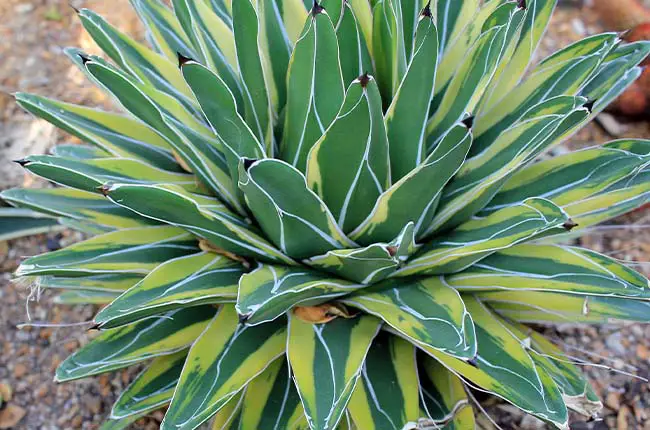
(Yinan Chen, Public Domain, via Wikimedia Commons)
2. Butterfly Agave, Variegated
Common name: Variegated Butterfly Agave
Botanical name: Agave Potatorum variegated
The Butterfly Agave has perfectly symmetrical fleshy leaves with a beautiful gray to a silvery blue hue, a terminal spine and red-colored spines that fringe the edges of its leaves.
Each leaf can grow up to 18 inches (46 cm) long and the whole plant can grow up to 10 feet (3 meter) tall.
When the Butterfly Agave blooms, it produces a death bloom that can be 20 inches (50 cm) tall and sprouts flowers that are a pale green-yellow color with red bracts.
You can grow this plant from cuttings, bulbs, or collected seeds that are allowed to dry..

(MidgleyDJ, CC BY-SA 2.5, via Wikimedia Commons)
3. Bishop’s Cap Cactus, Variegated
Common name: Variegated Bishop’s cap cactus, bishop’s hat
Botanical name: Astrophytum myriostigma Variegated
The Bishop’s Cap is recognized by its globular and star-like stem that rises like a thick column without any spines and cactus arms.
The variegated varieties exhibit a unique combination of green and yellow mottling patterns. In some varieties, orange and red hues can also be seen.
From spring to summer, the cactus blooms with fragrant bright red and yellow daisy-like flowers that measure up to 2 inches (5 cm) wide and last for 2 days.
A mature Bishop’s Cap Cactus can reach up to 39 inches (1 meter) tall. It thrives in an arid and rocky environment just like its natural habitat in the mountains of northeastern Mexico.
4. Penis Cactus, Variegated
Common name: Penis Cactus, San Pedro Penis, Penis Plant
Botanical name: Echinopsis lageniformis monstruosa variegata
The Penis cactus derives its unique name from the clusters of smooth fleshy stems, usually found in a group of three resembling prostate growth. A few areoles and spines can also be found at the base of the stems.
It is a slow-growing cactus that usually grows up to 4-14 inches (10-35 cm) tall at maturity.
The variegated species have a pale, glaucous green color with creamy-yellow markings.
It is a hardy plant that grows well in soil with excellent drainage, full sun, and little water.
5. Cardon Grande Cactus
Common name: Cardon grande cactus or Argentine saguaro
Botanical name: Echinopsis terscheckii variegata
These distinctive, branching cacti grow in a tall green, fleshy and ribbed trunk with golden spines. Some species may develop arms that typically extend upward, and the plant can grow up to 25 feet (7.6 meter) tall.
The variegated species have a unique mottled pattern of yellow and green.
In the late springtime, prolific white flowers appear during warm nights and last through most of the next day. In summer, red fruits sprout among the spiny branches.
This plant grows fast and tolerates both humid and drought conditions well.
6. Night-blooming Hedge-hog
Common name: Night-blooming Hedge-hog, Easter Lily cactus
Botanical name: Echinopsis subdenudata variegated
The Echinopsis subdenudata is a fleshy, globular stem that grows to about 3 inches (8cm) in diameter with very short creamy-white spines.
Its green stem is marked with an asymmetrical yellow pattern.
They produce tall and large fragrant blooms at night with different colors, although white is a common color.
These plants require full sunlight, good drainage, sparse watering, and can withstand a brief frost.
7. Ghost Euphorbia
Common name: Ghost Euphorbia
Botanical name: Euphorbia Ingens Variegata
This rare, tall cactus is prized by collectors for its unusual green and white mottled pattern on a ribbed stem with black spines.
The Ghost Euphorbia has an erect stem with a couple of smaller branches that bear tiny yellow or white flowers in the spring through summer. When these plants are potted or grown indoors, they almost never bloom.
Because they originate in dry or sub-tropical climates, the Ghost Euphorbia cactus does well in dry soil and arid environments.
8. Variegated Elkhorn
Common names: Variegated Elkhorn, Variegated Candelabra Plant, Variegated Frilled Fan, Alabaster Swirl, Variegated Crested Euphorbia
Botanical name: Euphorbia Lactea cristata variegata
This unique cactus has crested, fan-shaped branches with colors that range from pink, violet, yellow and green.
It can grow up to 3 feet (90 cm) tall.
As a member of the Euphorbia family, it produces a skin-irritating white toxic sap when plant tissues are broken.
The plant is drought-tolerant and thrives in either full sun or partly shaded areas with good drainage and little water.
9. Corn Cob Cactus
Common name: Corn cob cactus, corkscrew euphorbia
Botanical name: Euphorbia Mammillaris f. variegata
This unique cactus has a columnar stem that is shaped like a cob of corn and is studded with long toothpick-like spikes in the middle of the stem. The pale white stem turns pink when exposed to strong light in winter.
It can grow up to (8-14 inches (20-35 cm) tall at maturity.
During late winter through early summertime, the Corn cob cactus blooms with yellow flowers that cluster at the top of each stem.
The care for the Corn cob cactus is easy. Water once per week in summer, and the plant can go up to a month between watering in winter. Always let the soil dry out in between watering.
Give the plant space and plenty of sunlight and watch the cactus propagate itself at its base.
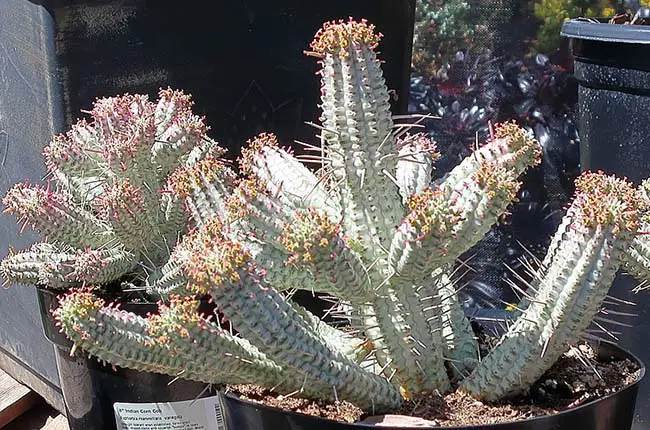
(cultivar413, CC BY 2.0, via Wikimedia Commons)
10. Moon Cactus
Common name: Moon cactus, Hothead cactus, Lollipop Cactus
Botanical name: Gymnocalycium Mihanovichii Variegated
The Moon Cactus is a red mutant cactus that is grafted onto a regular cactus in nurseries. It doesn’t contain any chlorophyll and is thus unable to synthesize its food.
The variegated cultivars come in a variety of bright shades of red, orange, pink, and neon yellow.
They are tiny plants that usually measure only about a half-inch long and can grow up to 4-12 inches (10-30 cm) at maturity.
11. Purple Prickly Pear
Common name: Redeye prickly pear, purple prickly pear, black-spine prickly pear,
Botanical name: Opuntia Violacea
The prickly pear is covered with large, round, flat fleshy leaves studded with dark-colored spines. It can grow up to 2-4 feet (60-120 cm) tall and 10 feet (3 meter) wide.
The flat fleshy leaves turn purple when under cool and dry conditions during winter as a way to respond to environmental stress. This is a mechanism similar to succulents turning reddish under sun stress.
Originated in the Sonoran Desert and in Mexico, the cactus needs full sun and is very drought-resistant.
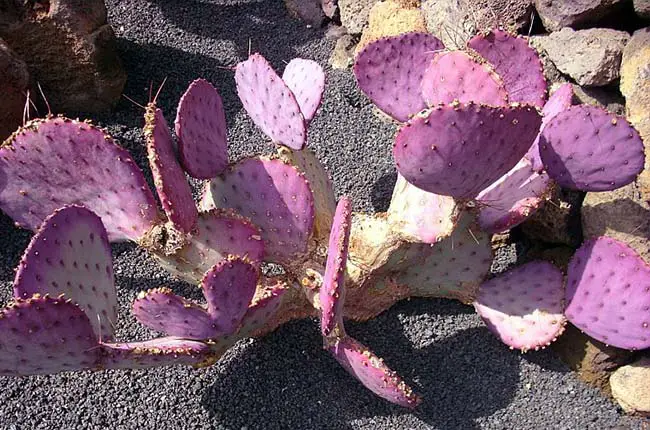
(Peter A. Mansfeld, CC BY 3.0, via Wikimedia Commons)
12. Joseph’s Coat
Common names: Joseph’s Coat, Eltham Indian Fig, Pak’an, Sweet Prickly Pear
Botanical name: Opuntia Monacantha f. monstruosa variegata
Joseph’s Coat is one of the few naturally occurring variegated cactus species.
This fleshy succulent cactus has a trunk with white, green and yellow marbled markings and tiny hair spines.
It is a dwarf variant of the Prickly pear cactus, growing up to 3.3 feet (1 meter) tall.
Joseph’s Coat enjoys access to full sunlight and well-drained soil.
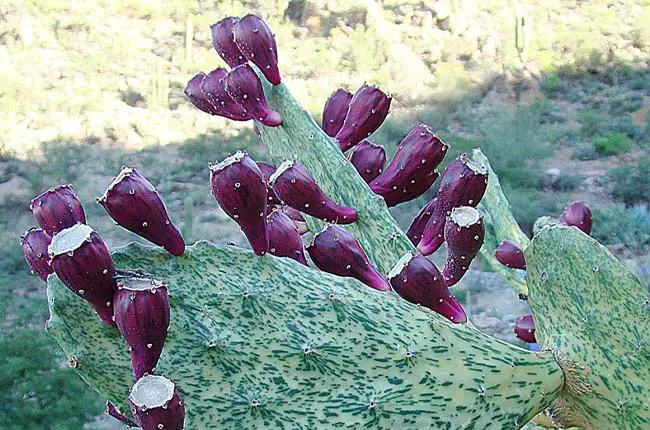
(Dick Culbert from Gibsons, B.C., Canada, CC BY 2.0, via Wikimedia Commons)
13. Blue Torch Cactus
Common name: Blue cactus, blue torch cactus
Botanical name: Pilosocereus Azureus
This splendid blue cactus has a trim and upright columnar stem with brilliant coppery gold spines.
Young plants have stems that only turn blue as the plant matures. This bright blue color is one of the rarest plant colors.
A Blue Torch Cactus’ flowers are big, showy, and spectacular white flowers with yellow centers. Each plant stem has between 5 to 19 ribs that are lined with sharp spines.
The cactus species is found in Brazil where it grows up an astonishing 12 feet (3.6 meter) tall when the plant is several decades old. This plant needs good drainage soil, full sunlight, and little water. Potted plants thrive best in mineral grit soil for succulents.
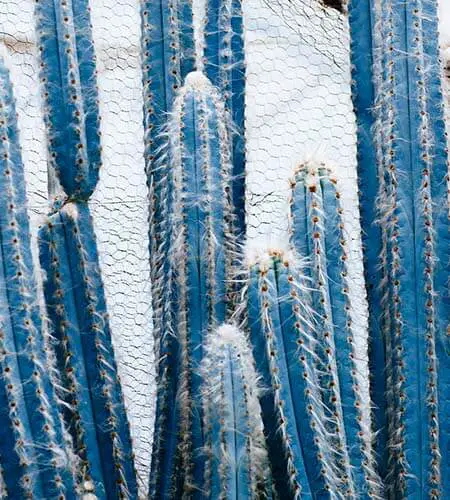
(Subhrajyoti07, CC BY-SA 4.0, via Wikimedia Commons)
14. Crested Variegated San Pedro
Common name: Crested variegated San Pedro
Botanical name: Trichocereus pachanoi f. cristata aurea / Echinopsis pachanoi f. cristata aurea
This rare cactus is prized for its thick central stem which looks like a fan-shaped brain mound that measures 12 inches (30 cm) in diameter.
The lack of green chlorophyll pigment gives it an attractive lemon-yellow color.
Instead of growing vertically, the Crested Variegated San Pedro cactus grows horizontally, flattening into visual folds and ribbons.
Its flowers are very fragrant and large, measuring up to 8.6 inches (22 cm) in diameter.
Which is your favorite? Tell us in our community.
Related
4 Ways To Induce Variegation In Plants (Explained)
14 Fragrant Succulents & Cacti (You Will Love)
4 Ways To Determine The Age Of Cactus
- Top 6 Drip Irrigation Systems for Raised Beds (2025) - January 31, 2025
- Top 10 Orchid Fertilizers: A Comprehensive Review (2025) - January 16, 2025
- Top 6 Slow-Release Fertilizers for Houseplants & Veggies (2025) - January 15, 2025
